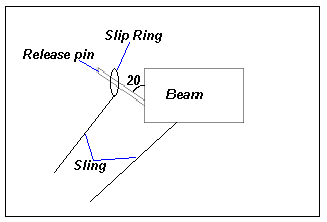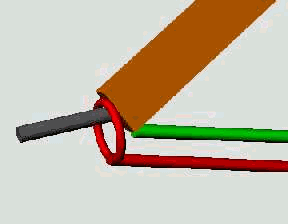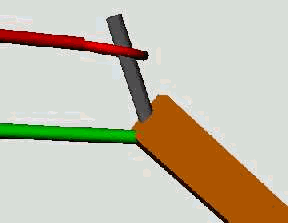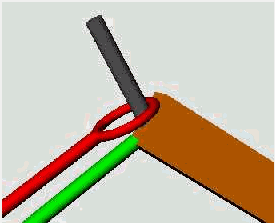
The Trebuchet:
The Ancient Throwing Weapon: The Trebuchet "leverage artillery"
The purpose of leverage artillery is to throw a projectile along great distance. To achieve this a counter weight is place on one side of the beam and the projectile is on the other. Gravity pulls the heavier counter weight over an axial pulling the projectile up in a centripetal way and throwing it up towards it target.
My Project:
Aim:
Variable Components:
Hypothesis:
I believe that the heavier the counter weight the further and harder the projectile is thrown. Making a longer range and thus a better weapon.
Also elevation might make the projectile be thrown further.
Method:
The counter weight (two bricks) is attached to the beam by duct tape. The axial is placed through a hole that has been drilled into the beam. The hole is has been drilled 23 cm along the beam, which is the length of a common brick. The axial is held up by supports. The pouch is attached to two pieces of string (the sling). One end of the sling is attached to the opposite end of the beam to the counter weight, the other end is attached to ring made out of a paper clip (the slip ring) which is placed on the firing pin (a nail nailed through the beam to the other side). I have nailed another piece of string to the end of the base and is tied to another slip ring, which is placed on the release pin after the pouch slip ring – this is my safety to stop an unwanted firing. From the safety slip ring I have tied string, I use it to pull and thus pulling the safety ring and thus firing.
When the trebuchet is fired the counter weight is pulled down by gravity and overbalancing the beam pulling the slings, pouch and counter weight up. The slip ring rotates round the release pin and is forced off and this makes the sling and pouch become straight so the beam, sling and pouch make a straight line. When this line reaches a certain point it slows but the projectile does not and so the projectile is thrown from the pouch and up or across. From the release point and the straight line is swung under the axial and come slows from the momentum.
The Model:
The Trebuchet is made out of wood for the frame and base, a rusty iron garden stake pole for the axial. Also nails and string.
The frame is made up of 20x50mm timber. Two vertically 700mm supports rise up from the base, 400mm supports are nailed on to the 700mm on the side and another support is nailed on to the width to the base, a brace is put in between the two 700mm so they stay in the exact position.
The axial is an old rusty garden stake which is put through the two 700mm and the arm and the top. The counterweight (a brick) is attached to the top of the arm, which pulls the front of the arm and so the bottom end will be pushed upwards. The beam moving upwards brings the firing assembly up and the projectile with it, firing it away.
Inaccuracies and Errors:
During the building a number of things were not accurate with the drawing and the opposite side of the trebuchet this is mainly because the limited timber I had, the timber I did have was in some cases bent slightly and so was not straight. Also the four main supports were from two timber 750mm long. I taped them together and cut them in the centre, so the four would be the same, but the saw didn’t want to do that or my markings were wrong. So two supports were 400mm and the other two were approximately 350mm long.
The weight – two bricks leans to one side of the arm sometimes and so one of them rubs against the axial creating friction and slowing the beam.
The counter weight is set o far forward and so it falls forward unless held down when firing.
Experimental trials/Research:
Once I had built the Frame I tried a number of components. I have explained what each component does and how it is made and have researched and tested each component and applied it to my model. I have written what parts I have tested and tried and written why I used this particular part.
The Release Pin:
Release pins are critical to when a sling lets a payload go. The length of the pin, angle, material and shape are all determining factors for the range. The slip ring should slide off the release pin easily and consistently. The angle of the release pin is very important it can increase the range or decrease it. My pin is a nail, which is pushed through the under side of the beam, to get the angle needed I just bent the nail.
To work out the greatest range for my model I used the formula
Velocity * Velocity / Gravity (9.8) to determine the natural range.
I worked out the Velocity by:
Velocity = 2*p * Radius / Time
I timed the swing of the Trebuchet from the loading point to the launch point and using the average as the time
|
1st |
2nd |
3rd |
4th |
5th |
Average |
|
0.75 |
0.67 |
0.56 |
0.80 |
0.57 |
0.67 |
I then measure the distance from the axial to the pouch on the sling, which gave me the radius.
So 2*p
= 6.283185307 r=1.055m / t= 0.67= 60628760499 / 0.67
= 9.893672387m/s
The range is
9.893672387m/s * 9.893672387m/s / 9.8 which is 9.988240132 metersOnce I had the natural range I compared it to the ranges of the different angles of the release pin
|
Degrees ° |
Range (m) |
|||
|
1st |
2nd |
3rd |
Average |
|
|
10° |
10.5 |
11.1 |
12.8 |
11.4 |
|
20° |
15.5 |
12.9 |
13.9 |
14.1 |
|
30° |
12.5 |
12.3 |
14.9 |
13.2 |
|
40° |
11.2 |
11.5 |
11.6 |
11.4 |
|
50° |
6.3 |
8.6 |
6.7 |
7.2 |
|
60° |
6.1 |
8.8 |
6.4 |
7.1 |
|
70° |
1.3 |
-0.60 |
0.4 |
1.1 |
|
80° |
||||
|
90° |
-4.0 |
-4.8 |
-2.2 |
-3.6 |
|
100° |
||||
|
110° |
-6.5 |
0.1 |
-8.8 |
5.0 |
|
120° |
||||
Some results I have not tested because my engine was becoming too dangerous - the safety slip ring could not hold on to the release pin.
Result:
I have found from my calculations and testing that an angle of 20° for the release pin angle, will fire the projectile a grand distance of 14.1 meters.

The Sling:
The first set of trials were testing different types of slings:
How the sling work:

At the moment of release, the projectile is on the ground. The sling lines get tight (pull of the counter weight) and start pulling the payload along. The green sling line is attached to stay with the beam. The red sling line is attached to the ring, which is over the release pin. The pouch is attached to both lines at the other end.
The throwing arm rotates around, the pouch is picked up from the ground and the firing assembly is forced up.



This is the way the sling works for centuries. If it were any different it wouldn’t be a trebuchet
Sling and Pouch:
"The problem facing the designer is to decide what the 'standard' payload is going to be and how much mass it has the important thing is to select materials for the pouch that will not break under the forces involved."
My sling is some netting that I cut out of my planet 8 pants
Sling Length:
Sling length and Pin Angle is the two most common elements to work with for tuning. Rule-of-Thumb for sling length is to make it equal to the length of the long portion of the throwing arm (from the axial to the end of the pin end of the beam), a 1:1 ratio. That is the length from the pouch to the end of one of the sling lines. The objective is to get the sling (and hence the pouch/payload) at the best angle for release. If the sling is too short, conservation of momentum will cause the sling to rotate around the end of the throwing arm quicker. This could mean that the sling would reach the best angle too soon. If this happens while the throwing arm is only half way most of the available energy is going to be lost,
If the sling length is too long, then it will lag behind the optimum point of release and again most of the energy is lost.
Result:
I tested the Trebuchet to find the right length and tuned it accordingly. Coming to the length of it is now at
xx meters.
Counter Weight, Beam and Axial
The problems with the counter weight is it need to be about ten times heavier than the projectile and beam to ooverbalance the beam to lift the projectile up to fire it. But the axial needs to be heavier enough to hold the beam and the counter weight and the beam needs to be thick enough to hold the counter weight to its self. The frame of the Trebuchet needs to be strong enough to hold the beam, counter weight and the axial up and no collapse.
Through the ages engineers of the trebuchet have found that the axial need to hold about ten times the counter weight. This ten times holds the counter weight and holds it up when the forces of the swing and gravity distorts the axial.
The Projectile:
The projectile is simple it needs to be strong enough to withstand the forces involved and to be light enough so the counter weight overbalances the beam.
My projectile is a golf ball - it being a totally round object makes it a fair test, no matter how you put the ball in the pouch it will fly through the air with the it cutting through the air with the same angle.
I also tried grape fruit quarters and eggs, both came just short of the natural range.
The result:
From my research I have found the following things to make the projectile be thrown the greatest distance (using my engine):
The frame:
The higher the axial is the higher the projectile is thrown. Having it on a higher elevation will throw it another XX meters
The axial:
Needs to be stronger enough to hold the beam and the counter weight. The axial doesn’t effect the rage at all but friction is created when the beam and axial grind together and this will slow the projectile and decrease the range.
The beam:
A longer beam will throw the projectile higher and thus further
The counter weighs:
A heavier counter weight will throw the projectile harder.
The sling:
The sling should be about the same size as the beam.
The pouch:
The pouch needs to be big enough to hold the projectile
The firing pin angle:
A pin angle of 20 degrees will throw the projectile longer. A lower pin angle will throw the projectile lower and thus longer but if the pin angle is two low (under 20 degrees), the projectile will arc too low and will hit the ground the early.
A higher pin angle will throw the projectile in a higher arc and so a shorter range but a harder fall.
Calculations
I used the following calculations to work out parts of my experiment.
Velocity: 2p * Radius / Time
2*p
= 6.283185307 r=1.055m / t= 0.67V = 60628760499 / 0.67
V = 9.893672387m/s
Range:
Velocity * velocity / gravity9.893672387m/s * 9.893672387m/s / 9.8
Range =9.988240132 meters
Launch velocity: square root (gravity * range)
= 9.8 *
9.988240132= 97.88475329 square root
= 90893672386
Conclusion
I have that a number of things will affect the range of the projectile. After tuning my trebuchet to the right counter weight weight and the sling and pouch length – these become a standard; there is no need to change them really.

A pin is placed in a tube, which is attached to the beam.
Having the engine on an elevation will help with the range an having it high will bring the projectile heavier because gravity has more time to pull the projectile down and this making a heavier fall on the target.
Evaluate
I found that after about twenty firings, repairs were need mostly the safety slip ring, which was a paper clip broke and so I replaced it with a galvanized wire loop. This also happened to the other slip ring. The safety slip ring string needed to be replaced three times because is stretched and broke and it got ripped from where it was attached to the base. Nails that I used to thread string through and pull the arm back down came out from the force of the arm pulling the string up and pulling the nails out, this action also broke the string and so I got rid of this part. The biggest repair was when the base cracked and broke in half, I nailed two planks under the base to attach the base back.
Another problem was that because the counter weight was to far forward so it tipped forward I had to attach the trebuchet to the barbeque table that I had it on with wire to hold it down.
When I was tuning my engine I used one brick instead of two, when firing with on brick my engine did not tip forward. So to fix this problem a one brick counter weight could be used or a longer base (out past the axial), side supports could also be used to counter act the force of the counter weight tipping the engine forward.
When I finished testing my engine is starting to get weak and wobbling a lot so extra nails and pins would be need to make it solid again.
But most of the repairs are just basic maintenance and the right engineer supplies would be taken into battle and the engine could be on the field for long amounts of time before major repairs would be needed.